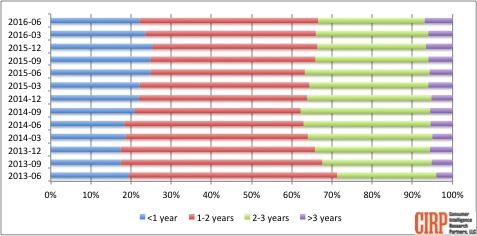Brand and feature options speed upgrade cycle, as iPhones see longer cycle
Consumer Intelligence Research Partners (CIRP) released additional analysis of the results from its research on the Android smartphone operating system from Google (NASDAQ:GOOG).
CIRP estimates loyal Android owners keep their phones for about the same length of time as they did three years ago. In the past three years, that length of time increased slightly, then decreased about the same amount, such that the average age of an upgraded Android phone increased only by about three weeks in the past three years.
Among buyers of a new Android smartphone that already owned an Android smartphone, in the past three years, the age of their retired Android phones increased for five quarters, then decreased since then (Chart 1).
In the year ending with the June 2013 quarter, 71% of previous Android phones were either under one year old or from 1-2 years old. This decreased to 63% in the year ending in the September 2014 quarter, and increased back to 66% in the year ending in the June 2016 quarter.
Similar to our analysis of iPhone upgrade cycles, we can translate these retiring Android smartphone age distributions into an estimate of the change in age of customers' previous Android phone. Over the four quarters from the year ending in June 2013 through the year ending in June 2014, the average age of an Android phone increased by slightly over one month. Since then, from the year ending in September 2014 through the year ending in December 2015 quarter, the average age of an Android phone decreased by almost one month. In the first half of 2016, the average age of a retiring Android phone increased by about one-half month.
Our earlier analysis of iPhone age indicates that the average age of an upgraded iPhone increased by more than three months over three years, while the age of upgraded Android phones increased by less than one month. We identified two potential reasons why iPhone upgrade timing has slowed: more incremental changes in features, and phone financing plans. Only the latter of these factors, phone financing, would apply similarly to Android phone upgrade timing. Other factors, including the ability to switch between manufacturers and remain within the Android operating system, the variety of features offered by different manufacturers, and the price competition that comes with multiple options, appear to lead to earlier upgrades.
Among the various Android brands, loyalty varies greatly. Since the June 2013 quarter, Samsung leads in loyalty, with 77% of Samsung consumers activating another Samsung phone. Loyalty trails significantly for other leading Android handset brands, ranging from 39% for LG to 25% for HTC.
CIRP bases its findings on its quarterly surveys of 2,983 Android customers that activated a new Android smartphone in the US in September 2012-June 2016 quarters. For additional information, please contact CIRP.
